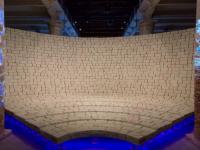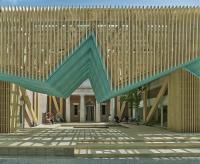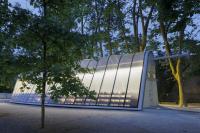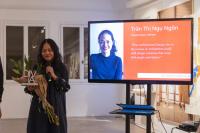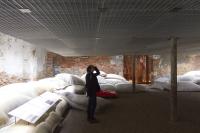Modernization and Refurbishment TUM
Munich, Germany
The building, constructed in 1963 pursuant to plans by Franz Hart, was badly in need of refurbishing. It no longer met modern energy and fire protection standards. Hild und K developed a new outer skin for the reinforced concrete building with a pre-fabricated facade. Its new skin relates both to the adjacent buildings on the grounds of Munich’s Technical University and to the original edifice. The house 0505 is constructed of alternating levels of reinforced concrete providing structural variety between the hall at ground floor level and the storeys above. The concept by Andreas Hild and Dionys Ottl absorbs the peculiarity of its predecessor and leads it to another level.
Alternating parapets and buttresses on the facade now echo the flight of the existing supports. From the second storey, they sweep back melding with the existing construction. The projection of the buttresses is graded upwards in a random manner. So, closest to the ground the buttress protrudes and then tapers vertically. The windows, flush with the facade, integrate optimally with the interplay of protrusion and plane. Their size and axis remain unchanged. Steel-grey clinker acts as mediator between the exposed bricks of the buildings from the fifties and sixties to the north and the aluminium facade of the new University buildings to the south. Simultaneously, the shimmering metallic surface serves to enhance the light breaking on the buttresses creating a vivid play of nuances and colours. The outer skin of bricks covers a layer of air and insulation to meet the highest modern standards.
The existing interior in need of refurbishing has been stripped back to its salient steel concrete skeleton. The light yellow tones of the corridors, seminar rooms and offices reflect the colours of the surrounding historical buildings and again create a bridge to the architectural context of the area. Large windows underline the connection between outer and inner spaces securing an optimal supply of daylight to the working areas. The offices benefit from manually regulated natural window ventilation and integrated sun and glare protection. Lecture halls, laboratories and meeting rooms will be air-conditioned and have a heat recovery system. Additionally, a new district heating connection insures the building is optimised to feed from renewable energy sources thus reducing CO² emissions. A further phase envisages refurbishing another part of the building in similar manner. The existing main entrance which is recessed will be projected towards the street. It will lead to a skylighted central area extending to roof level in which existing stained glass windows will be fully emphasised.
- Architects
- Hild und K
- Location
- Munich, Germany
- Year
- 2013
- Client
- Freistaat Bayern, vertreten durch Staatliches Bauamt München 2
- Team
- Andreas Hild, Dionys Ottl, Beate Brosig, Ina Fidorra, Henrik Thomä, Julianna Eger, Daniela Hambauer, Markus Schubert, Eva Walczyk






